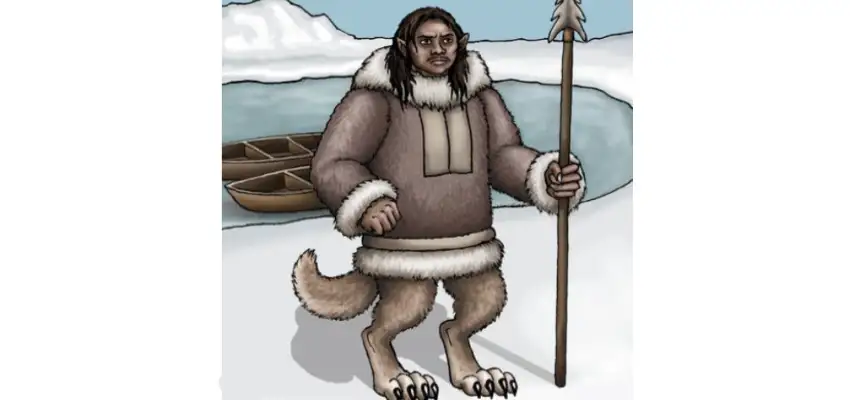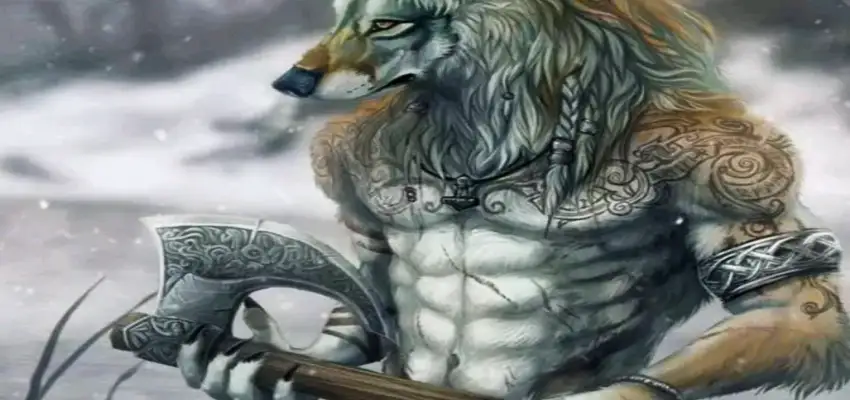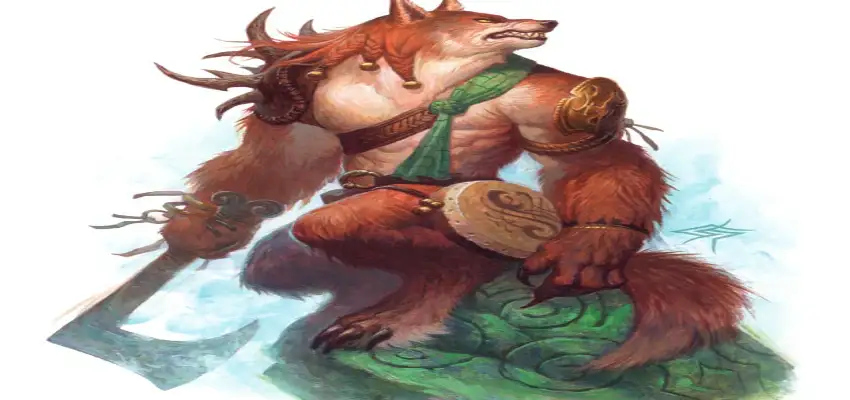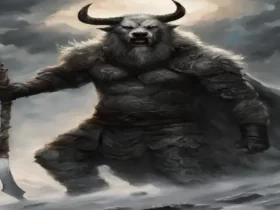The Adlet, also known as Erqigdlet, is a mythical species in the folklore of Greenland, Labrador, and Hudson Bay regions. Though the term typically describes indigenous American groups living inland, it also refers to a bipedal tribe with canine features, where the lower half of their body resembles a dog’s, and the upper half resembles a human’s. The legendary Adlet are known for their swiftness, but whenever they confront humans, the humans typically emerge as the victors.
Adlet: A Fearsome Humanoid & Dog Legged Creatures

According to Inuit mythology, the Adlet are often depicted as being at odds with humans and are believed to be taller than both Inuit and white people. Some stories even portray them as cannibals. The term “Adlet” is used by the Inuit from Labrador, while those from the Hudson Bay area use the word “Erqigdlit.”
The monstrous offspring of the Adlet was associated with indigenous American tribes by the Labrador and Hudson Bay Inuit. However, the Inuit from Greenland and Baffin Land, who had no neighboring indigenous American tribes, used the term to describe the humanoid, dog-legged creatures.
Etymology
H. Newell Wardle proposed two possible origins for the term “Adlet.” First, it might come from the word “ad,” meaning “below,” which would suggest that the Adlet are those who are inferior or lower than humans. Alternatively, it could come from the stem “agdlak,” meaning “striped or streaked,” which would refer to the indigenous American tribes who painted their faces and lived in the western regions. Wardle also suggests that “Erqigdlet” may be a derogatory term for the same people. The term “Atlat,” on the other hand, means “others” from the Inuit perspective, but Wardle considers this possibility secondary and based on phonetic similarity.
Must Read: 3 Headed Dog Cerberus & 11 Horrifying Facts
The Hair-raising Legend Of Adlet & Its Origin

An account of the creation of the Adlet is provided by Franz Boas, an ethnologist who collected many Inuit myths. Boas first heard the legend in Baffin Land, more specifically in Cumberland Sound, from an Inuit man by the name of Pakaq. His transcription, with a translation by H. Rink and an explanation (by Boas) were printed in The Journal of American Folklore in 1889. Rink claims that the Inuit of Baffin Land and Greenland share the same narrative.
On the west coast of Greenland, the tale is frequently referred to as “The Girl and the Dogs,” whereas on the east coast, it is known as “The Origin of the Qavdlunait and Irqigdlit” (or Scandinavians or Nordic people and Indians).
The story of the origin of the Adlet involves a woman named Niviarsiang, also known as “the girl” or “she who wouldn’t take a husband,” who refuses to marry any of her suitors. She ultimately marries a dog named Ijirqang, who has white and red spots. Together they have ten children, five of whom are dogs and the other five are Adlet.
The Adlets have the lower body of a dog and the upper body of a man. However, Ijirqang does not hunt, and the family becomes very hungry. Niviarsiang’s father, Savirqong, takes them to a small island and instructs Ijirqang to come to the mainland daily for meat. Niviarsiang gives Ijirqang a pair of boots to wear, but Savirqong puts stones in them, causing Ijirqang to drown.
Niviarsiang seeks revenge by sending the young dogs to gnaw off her father’s hands and feet. In return, Savirqong kicks Niviarsiang overboard from his boat, and when she hangs on the gunwale, he cuts off her fingers. Her severed fingers fall into the ocean and transform into whales and seals.
Niviarsiang is afraid that her father will harm the Adlet, so she sends them inland where they eventually become a numerous people. She also sends the young dogs across the ocean in a makeshift boat, and they become the ancestors of Scandinavians upon their arrival.
Interpretation And Stories From Different Tribes
One interpretation of the Adlet and the “Dog Husband” myth suggests that the difference between the dog-like children and the Adlet is important. According to one interpretation, the dogs are sent across the ocean and are expected to return as white Scandinavians who will bring beneficial things for the Inuit people.
On the other hand, the Adlet, described as “swift runners of an aggressive disposition,” become an inland spirit that must be kept away. This interpretation suggests that the “Dog Husband” myth reflects a cargo cult mentality in which Inuit daughters offer their sexual favors to the dog-like white men, or Nords, to act as mediators to obtain desirable goods.
Another reading of the myth is as a “Whaler myth,” which transforms the Inuit’s economic dependence on the mechanically superior products supplied by Scandinavian whalers into a reciprocal relationship, in which the Scandinavian Nord returns to repay his mother.
Franz Boas and Hinrich Rink present two possibilities for the origin of the legend that explains the origin of Nordic people. The first possibility is that the legend dates back to the time when the Inuit first encountered Scandinavians, which they find improbable. The second, more likely possibility is that the legend is a modification of an already existing tradition, which was adapted to incorporate the arrival of the Scandinavians. Signe Rink puts forth a similar hypothesis that takes into account linguistic evidence.
Must Read: Werehyena: 14 Intriguing Facts (With Myths, Folklore & Cryptozoology)
Other tribal mythologies also have stories similar to the “Dog Husband” theme. The Dakelh tribe, who are indigenous to the inland of British Columbia, tell a story in which a woman suspects she is being violated nightly and identifies the violator as a big dog after throwing a little bag of vermilion paint on it. She later gives birth to four dogs.
Father Morice, who had been told this and other stories by the Carrier people, suggests that there could be a shared cultural tradition among the indigenous peoples of the Arctic region of America, as evidenced by the fact that even the Eskimos have a similar story. He then summarizes Franz Boas’ account of the story in The Central Eskimo (1888). Similar stories about the Adlet and women marrying dogs are also told among the Chukchi on the Siberian side of the Bering Strait.
The Tornit and the Adlit: Legends Of Violent & Cannibalistic Adlet

A.L. Kroeber collected and published a number of stories told by an Inuit named “Smith Sound Eskimo” who was in New York City during the winter of 1897-1898. One of the tales involves two Tornits who find themselves among cannibalistic Adlet. The Tornits sneak out at night and cut the thongs on the Adlet’s sledges, causing the runners to fall off and enabling them to escape. Another story told by the same Inuit is a variation of the Adlet story told by Franz Boas in “The Central Eskimo.” In this version, the Tornits are also the woman’s offspring, but Kroeber notes that this is not typically part of the tale. Other stories shared by the Smith Sound Eskimo, such as “The Origin of the Narwhal,” also feature violent Adlet.
Don’t Skip: 12 Legendary Humanoid Cats From Comics & Fiction
Aselu: A Variation Of Adlet
According to Inuit mythology from Point Barrow, Alaska, there is a story about a dog named Aselu who was initially tied to a stick. However, he managed to free himself by biting through the stick and then proceeded to have intercourse with a woman. As a result, the woman gave birth to both men and dogs.





